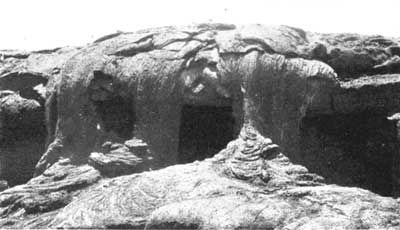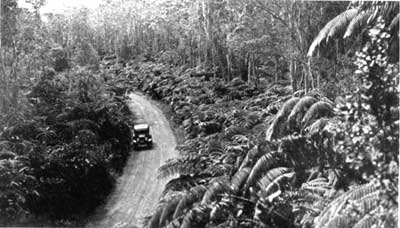MENU
![]() Hawaii
Hawaii
|
Glimpses of Our National Parks |
 XIII
XIII

THE HAWAII NATIONAL PARK
HAWAII
Special Characteristics: Large Volcanoes, Two Active, Including the Periodic Kilauea Lake of Fire
 Lava Cascades—Hawaii National Park |
THE Hawaiian islands are a land of coral reefs, tropical palms and flowers pineapples and sugarcane, sculptured mountains, rainbows, music, earthquakes, and volcanic violence. They have a history which is a romance. Their very mention evokes visions of girls dancing under tropical stars to the ukulele or ancient drums. They possess the fourth largest volcanic crater in the world, the largest active volcano, and a lake of turbulent sulphurous fire, which fills the beholder with awe.
It was not the gentle poetic aspects of the Hawaiian Islands which led Congress to create a national park there, though these form its romantic contrasted setting. It was the extraordinary volcanic exhibit, that combination of thrilling spectacles of Nature's colossal power, which for years has drawn travelers from the four quarters of the earth. The Hawaii National Park includes the summits of three volcanoes of world celebrity—Haleakala, on the island of Maui, and Mauna Loa and Kilauea, on Hawaii.
There are 12 Hawaiian islands in all, 8 of them hospitable enough for habitation. They rose from the ocean's bottom in a series of submarine eruptions. Coral growths have enlarged and enriched some of them since. Kauai was the first island to develop habitable conditions, and those to its southeast followed in order. Hawaii, the youngest, is still in the building. Dormant Haleakala on Maui has been inactive for centuries.
HALEAKALA
The popular translation of the name Haleakala is "The House of the Sun"; literally the word means "The house built by the sun." The volcano is a monster of more than 10,000 feet, which bears upon its Summit a crater of a size and beauty that makes it one of the world's show places. This crater is 7-1/2 miles long by 3 miles wide. Its surrounding walls rise more than 1,000 feet. Its broad, rolling, rainless, sandy floor is decorated with plants famous under the name of silverswords—yuccalike shrubs 3 or 4 feet high, whose slender leaves gleam like polished stilettos. From this great multicolored floor within its lava rim rise, to a height of several hundred feet, 13 volcanic cones. "It must have been awe inspiring," writes William R. Castle, "when its cones were spouting fire, and rivers of scarlet molten lava crawled along the floor." That the crater was left in all its beauty is due to the fact that enormous side vents drained the fires from below.
Sunrise and sunset are the magic hours when the immense bowl and its cratered cones catch a hundred fleeting tints to mingle with their silver. Midnight and moonlight parties climb the mountain to see the sunrise glories, or make the trip in the afternoon in order to have the additional enjoyment of the wonder of the sunset. Visitors return loquacious with the myriad charms of the islands but silent about Haleakala's morning and evening splendor; it baffles speech. Sometimes at the sunset hour is seen the Brocken specter. The lowering sun throws upon the rising mists the shadow of the watcher upon the rim and encircles it with a rainbow frame.
MAUNA LOA
Upon the island of Hawaii, across 60 miles of water from Maui, another section of the national park encloses Mauna Loa, greatest of living volcanoes, and Kilauea's celebrated lake of fire. These are different volcanoes but so huge has grown Mauna Loa, the greater and the younger, that Kilauea has been nearly absorbed in his spreading flank.
Mauna Loa soars 13,680 feet. Its snowy dome shares with Mauna Kea, which rises even higher, the summit honors of the islands. From Hilo, the principal port of the island of Hawaii, Mauna Loa suggests the back of a leviathan, its body hidden in the mists. The way up, through forests of ancient koa and tangles of giant tree fern, then up brilliantly colored lava slopes, is one of the inspiring tours in the mountain world. The summit crater, Mokuaweoweo, is 3 miles long by 1-1/2 miles wide.
This enormous volcanic mass has grown of its own output in comparatively a short time. For many decades it has been extraordinarily frequent in eruption. About every 4 years it gets into action with a beautiful pyrotechnic display either within its summit crater or from fissures on its sides which send streams of molten lava writhing down the mountain's slopes.
Between November 21, 1935, and January 2, 1936, Mauna Loa erupted spectacularly, sending down its flanks a tremendous flow of lava which for a time threatened the city of Hilo. Bombing of the lava flow on December 27 so lessened the activity that the danger was averted and the flow gradually ceased.
KILAUEA
The most spectacular portion of the park is that including the volcano of Kilauea, usually the most active. This volcano, probably older than the towering Mauna Loa, its neighbor, creates the impression of being a crater in the side of a higher mountain, although in realty it is itself a mountain with an elevation of more than 4,000 feet. This illusion is the result of the broad depression at its top and of its gentle slopes, caused by lava flows from many lateral vents.
Within the depression is a vast pit, Halemaumau sometimes called the "House of Everlasting Fire". This pit often contains a boiling, bubbling mass of molten lava whose surface fluctuates from bottom to rim. Activities averaging at least one outbreak a year have occurred since 1924. Its risings are accompanied by brilliant fountains and inflows of liquid lava, and its lowerings by tremendous avalanches which send up enormous dust clouds.
Nearly a century and a half ago Kilauea became unusually active, and its violent blast of ash destroyed a Hawaiian army. From that time—1790—no rocks or ash were ejected until 1924. During the autumn of 1923 the lake of fire drained away, but gradually returned until the pit contained a 50-acre lake of seething lava. Lava geysers appeared on its surface, sending up incandescent sprays 150 feet into the air. In 1924 this lake disappeared and crumbling masses of rock fell into the smoking pit, choking the vents through which the volcanic gases had escaped. A few months later, when steam blasts unexpectedly occurred, the vents were cleared by tremendous explosions hurling boulders and ash for thousands of feet into the air. The violent disturbance continued for 3 weeks, and at the end of that time the fire pit had been enlarged to four times its former size, the opening being 190 acres in area and 1,200 feet deep. A few weeks later, when all was quiet, a roaring jet of lava appeared at the bottom of the pit, sending up a steady spray 200 feet high, building up a small cinder cone and forming a 10-acre lava lake on the floor of the pit. After giving a brilliant display for a couple of weeks the fountain subsided and the volcano became dormant. In July 1927 a similar display occurred, lasting for 2 weeks, and in January 1928 the fire returned for 1 night only. Gas and vapor rise continually.
 Fern jungle—Hawaii National Park |
During 1929 spectacular lava inflows occurred in February and July, raising the floor with new material to depths of 55 and 45 feet, respectively. The pit depth in December 1929 was 1,050 feet and the floor area 48 acres. On November 19, 1930, molten lava again appeared in Halemaumau. Activity continued until December 7. This activity raised the floor of the pit 70 feet; the surface area of the floor then covered 62 acres.
Following a series of earthquakes, molten lava broke into the bottom of Halemaumau on December 23, 1931. The activity lasted as a spectacular display until January 5, 1932. During the activity the pit was filled to a depth of 100 feet with lava, resulting in a new floor of 88 acres, which was 860 feet below the rim of the pit.
In the early morning of September 6, 1934, at about 2:45 a.m., without much preliminary warning, molten lava again returned to the fire pit in Kilauea. This eruption in its early stages was one of the most spectacular on record. Highly charged with gas released from tremendous pressure the frothy lava burst through a crack 700 feet long, halfway up the western wall of the crater, cascading in rivers of fire 425 feet to the floor below. The force of the lava cracked open the old floor left by the 1931-32 eruption across its northern and northwest end, and along the foot of the western wall dense clouds of sulphur fumes poured out, as the fiery fountains shot the liquid lava high into the air. As in the previous eruption, blocks of light pumice thrown out from the vents were whirled upward by the heat currents and gales of wind and deposited in shattered fragments over the land for more than a mile to leeward. In a few days the crater had been filled with new lava to a depth of 70 feet, and instead of the countless frothy fountains of the initial outbreak the activity centered in a lake of fire with from 5 to 10 fountains continuously throwing jets of heavy liquid lava from 50 to 200 feet above the lake.
TROPICAL VEGETATION AND RARE NATIVE BIRDS
The Park is also noted for its luxuriant tropical vegetation, which forms a striking contrast to the volcanic craters and barren lava flows. Gorgeous tree ferns, sandalwood, and koa vie with the flowering ohia trees in making the forests unusually interesting to the visitor.
Kipuka Puaulo, a beautiful natural park, also known as Bird Park, is an interesting feature of the Kilauea area. This kipuka or oasis has escaped encircling lava flows, and its rich black soil supports a marvelous variety of vegetation. As many as 25 species of trees grow here. This favored spot of 100 acres is the haunt of many beautiful and rare native birds.
 Top
Top
Last Modified: Fri, Sep 1 2000 07:08:48 pm PDT
http://www.cr.nps.gov/history/online_books/glimpses1/glimpses13.htm
![]()
